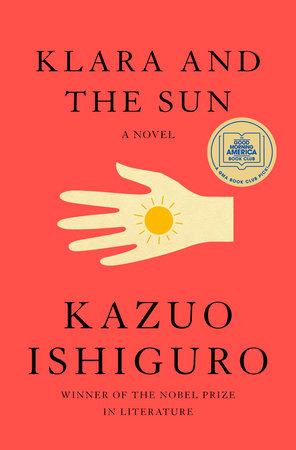Klara and the Sun: A Novel
- By Kazuo Ishiguro
- Knopf
- 320 pp.
- Reviewed by Carrie Callaghan
- March 3, 2021
Though opaque in places, this moving tale eventually lets in the light.

In Greek mythology, Helios the Titan is the golden sun driving his chariot across the sky. He scorches and sees all in a mighty demonstration of godly power. But despite his divine mystery, we have a sense that we know his refracted humanity. Through stories about his covetousness or rage, we feel Helios’ emotions.
Now, our sun, that burning star, is measurable. Even if science hasn’t yet calculated all its mysteries, we know its size and gravity and the types of visible and invisible light waves it emits. Our sun seems more like a machine: mysterious at first, but fundamentally knowable.
The question of knowing, of whether it is possible to plumb the depths of human hearts, animates Kazuo Ishiguro’s Klara and the Sun. Through the dual mysterious relationships of an android-like Artificial Friend (AF) with her owner and the Sun, Ishiguro suggests we may never know.
Klara is a particularly perceptive AF. As she sits amid her kind in a sleek store like puppies waiting for their forever homes, she watches the cityscape outside the window. AFs are solar powered — or nourished by the Sun’s generosity, as Klara puts it. She eagerly leans her face into the Sun’s light and watches, astonished, as the Sun seems to heal and even revel in the humans passing by.
As with many of Ishiguro’s books, Klara’s outsider status and tenuous (though undeniable) humanity make her a perfect foil for the people she encounters. She is soon taken home by Josie, a teenager struggling with a mysterious, potentially fatal illness.
Klara learns to fit herself into the delicate patterns of Josie’s home by respecting Josie’s divorced Mother and largely avoiding Melania Housekeeper. Fiercely devoted to Josie, Klara wonders how she can arrange for the Sun’s nourishment to heal her young charge while marveling at the strange interactions around her.
Mother forces Josie to socialize with other “lifted” children, the meaning of which isn’t clear at first but relates to some sort of gamble parents make to elevate their kids’ chances of success. The stakes of success are high, as evidenced by Josie’s father, who is among the many who lost their jobs to automation and now live in violent communes — though we don’t learn that dystopian detail until more than halfway through the book.
Throughout the novel, in scenes that feel like abstract sketches colored with splashes of vivid detail, Klara focuses on saving the ever-weakening Josie. Her efforts to do so lead her into conversation with Josie’s father as they drive around an unnamed city looking for a vaguely described machine. He asks Klara:
“Do you believe in the human heart? I don’t mean simply the organ, obviously. I’m speaking in the poetic sense. The human heart. Do you think there is such a thing?”
Klara affirms that she does, and suggests the heart is like a house with many rooms. Given enough time, she could wander those rooms and learn them. Father wonders, though, if the human heart might be unlike a house; if it, rather, has infinite rooms with unknowable depths.
Klara was created to assuage loneliness, to accompany lonesome children, and she is confident that no matter the complexity of the human heart, it remains finite. The more she learns, however, the less certain she becomes. As she develops her own mysteries and watches relationships unfold in surprising ways, Klara assures us that humans are, in the end, ineffable and profound even to something with her great intelligence.
It is the matter of her intellect that both drives the plot and frustrates the reader. Klara is perceptive and knowledgeable, but she is convinced the Sun steps into a barn at the edge of the Western horizon to spend each night, like Helios resting his chariot.
She also uses strange diction with awkward phrasing, including addressing other characters in the third person. Extreme emotions seem to pixelate or fragment her vision; she describes seeing things in boxes, though exactly what that signifies is unclear. Yet she deduces conclusions about the schemes of the humans around her from limited information.
Ultimately, Ishiguro suggests that Klara may be more knowing that we are, and that her pursuit of unlocking the human heart might make her more human than ourselves. Like it is for Kathy and Ruth in his masterpiece, Never Let Me Go, the gift of life is all the more precious to Klara because of her inability to fully hold it.
But Klara is a more inscrutable character than Ishiguro’s previous outcasts and outsiders, and trying to access her heart feels a little like grasping at sunlight. It should be scientifically possible, yet we feel the rays have slipped through our fingers.
Still, like sunlight, this story nourishes and warms. Ishiguro may worry about our future, about our ability to cohere as a society, but he remains convinced of our capacity for love. We may not be able to ease loneliness or rise above our petty competitions, but we can know we have lived by how we have loved.
Carrie Callaghan is the author of the historical novels Salt the Snow and A Light of Her Own (Amberjack/CRP). She lives in Maryland with her family.

